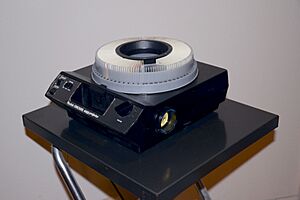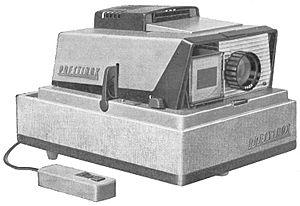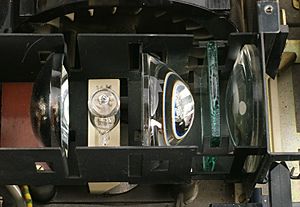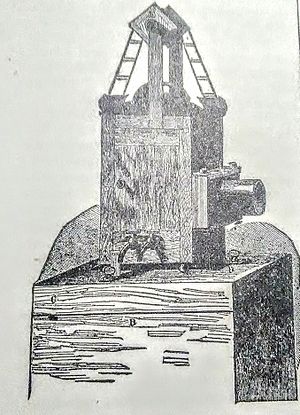Slide projector facts for kids
A slide projector is a special machine that shows pictures from small, clear slides onto a big screen. It uses light and lenses to make the tiny picture much larger so everyone can see it.
Slide projectors became very popular in the 1950s. Families and friends would gather to watch slide shows at home. People took pictures on special film called reversal film during holidays or family events. These pictures were then made into slides. Projectors were also used a lot in schools and other places for teaching.
Today, most people use digital pictures instead of slides. They show these pictures on a video projector or a large computer screen.

Contents
History of Slide Projectors
The idea of projecting images is quite old. Early versions, like the magic lantern, showed hand-painted pictures. Slide projectors are like a modern version of these old lanterns.
First Continuous Projector
In 1881, a new type of projector was invented. It was called a "continuous-slide lantern." This machine could show many slides one after another. It also had a special feature called "dissolving views." This made one image slowly fade out as another faded in.
How a Slide Projector Works
A slide projector has four main parts that work together to show your pictures.
Main Parts of a Projector
- Light Source: This is usually a bright light bulb. It needs a fan to keep it cool so it doesn't get too hot.
- Reflector and Condensing Lens: These parts collect the light from the bulb. They focus it into a strong beam that shines through the slide.
- Slide Holder: This is where you place your slide. It holds the slide perfectly in the path of the light.
- Focusing Lens: This lens takes the light that has passed through the slide. It then makes the image bigger and focuses it clearly onto the screen.
Protecting the Slide
To stop the slide from getting too hot, a special piece of glass is often used. This glass lets the light we see pass through. But it blocks heat, which is called infrared light. This keeps your precious slides safe from damage.
Seeing the Image
The light goes through the clear slide and then through the lens. This creates a large image. This image is then projected onto a flat screen. You can see the picture by looking at its reflection on the screen.
Sometimes, projectors use a "rear projection" screen. This screen is see-through, and the image is projected onto the back of it. This is good for continuous displays. It also stops people from casting shadows on the picture.
Different Kinds of Slide Projectors
There are many types of slide projectors. Each one has a slightly different way of holding and showing slides.
- Straight-tray slide projectors: These use a long, straight tray to hold slides.
- Round-tray slide projectors: These use a round tray, often called a "carousel," to hold many slides.
- Stack-loader slide projectors: These let you stack slides directly into the projector without a tray.
- Slide cube projectors: These use special cube-shaped holders for slides.
- Dual slide projectors: These have two projectors working together.
- Single slide projectors: These are often manual, meaning you change each slide by hand.
- Dissolve projectors: These can smoothly fade one image into another, like the old continuous lanterns.
- Viewer slide projectors: These are small and let you look at slides up close, sometimes without needing a big screen.
- Stereo slide projectors: These show two slides at once. They use different light polarizations. If you wear special glasses, the images look three-dimensional.
- Medium-format slide projectors: These are for slides that are bigger than standard 35mm.
- Large-format slide projectors: These are very powerful. They are used for big events or advertising. They can project very bright images onto large surfaces.
- Overhead projectors: These are a different type of projector. They project images from clear sheets of plastic (transparencies) placed on a flat surface.
See also
 In Spanish: Proyector de diapositivas para niños
In Spanish: Proyector de diapositivas para niños





